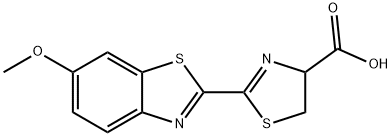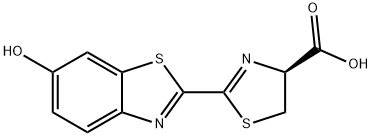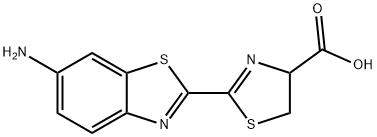D-LUCIFERIN
- CAS NO.:55963-96-7
- Empirical Formula: C11H8N2O3S2
- Molecular Weight: 280.32
- MDL number: MFCD00042929
- EINECS: 219-981-3

What is D-LUCIFERIN?
Description
From?The Merck Index, 10th edition: “Light emission in the American firefly,?Photinus pyralis, has been shown to involve the interaction of magnesium ion, oxygen, ATP [the coenzyme adenosine triphosphate], the enzyme luciferase, and the oxidizable substrate luciferin.”?Photinus?is one genus of the firefly family Lampyridae.
In 1957, B. Bitler and W. D. McElroy at Johns Hopkins University isolated 9 mg of luciferin from ≈15,000 Japanese fireflies (Luciola cruciata). McElroy, E. H. White, and co-workers?elucidated its structure and synthesized it in the lab?in the early1960s.
Crystalline luciferin is fluorescent; it absorbs 327-nm UV radiation and emits visible light at 530 nm. Light emitted from fireflies ranges from green (510 nm) to red (670 nm). Luciferin has been used in an assay for ATP, with a sensitivity for the coenzyme in solution as low as 10–11?M.
The name luciferin comes from the Latin?lucifer, or light-bearer. Lucifer, of course, in Christian tradition is the name of Satan before his fall. So if it’s warm enough to see fireflies on Halloween, you can blame it on climate change and the devil.
Properties of D-LUCIFERIN
| Melting point: | 200-204 °C |
| storage temp. | −20°C |
Safety information for D-LUCIFERIN
Computed Descriptors for D-LUCIFERIN
New Products
(S)-3-Aminobutanenitrile hydrochloride 4-Methylphenylacetic acid N-Boc-D-alaninol N-BOC-D/L-ALANINOL Tert-butyl bis(2-chloroethyl)carbamate 3-Morpholino-1-(4-nitrophenyl)-5,6-dihydropyridin- 2(1H)-one Furan-2,5-Dicarboxylic Acid Tropic acid 1-Bromo-3,5-Di-Tert-Butylbenzene S-2-CHLORO PROPIONIC ACID ETHYL ISOCYANOACETATE 2-Bromo-1,3-Bis(Dimethylamino)Trimethinium Hexafluorophosphate 4-IODO BENZOIC ACID 3-NITRO-2-METHYL ANILINE 1-(2,4-DICHLOROPHENYL) ETHANAMINE (2-Hydroxyphenyl)acetonitrile 4-Bromopyrazole 2-(Cyanocyclohexyl)acetic acid 4-methoxy-3,5-dinitropyridine 1-(4-(aminomethyl)benzyl)urea hydrochloride 2-aminopropyl benzoate hydrochloride diethyl 2-(2-((tertbutoxycarbonyl)amino) ethyl)malonate tert-butyl 4- (ureidomethyl)benzylcarbamate Ethyl-2-chloro((4-methoxyphenyl)hydrazono)acetateRelated products of tetrahydrofuran



![LUCIFERIN, [BENZENE-14C(U)]-,LUCIFERIN, [BENZENE-14C(U)]-](https://img.chemicalbook.in/)

![D-LUCIFERIN, [(S)-2-(6-HYDROXY-2-BENZOTHIAZOLYL)-2- THIAZOLINE-4-CARBOXYLIC ACID]](https://img.chemicalbook.in/)


You may like
-
 2033-24-1 98%View Details
2033-24-1 98%View Details
2033-24-1 -
 42831-50-5 5-METHYLISOXAZOLE-4-CARBOXYLIC ACID 98%View Details
42831-50-5 5-METHYLISOXAZOLE-4-CARBOXYLIC ACID 98%View Details
42831-50-5 -
 1975-50-4 98%View Details
1975-50-4 98%View Details
1975-50-4 -
 2-HYDROXY BENZYL ALCOHOL 98%View Details
2-HYDROXY BENZYL ALCOHOL 98%View Details
90-01-7 -
 2-Chloro-1,3-Bis(Dimethylamino)Trimethinium Hexafluorophosphate 221615-75-4 98%View Details
2-Chloro-1,3-Bis(Dimethylamino)Trimethinium Hexafluorophosphate 221615-75-4 98%View Details
221615-75-4 -
 61397-56-6 CIS BROMO BENZOATE 98%View Details
61397-56-6 CIS BROMO BENZOATE 98%View Details
61397-56-6 -
 14714-50-2 (2-Hydroxyphenyl)acetonitrile 98+View Details
14714-50-2 (2-Hydroxyphenyl)acetonitrile 98+View Details
14714-50-2 -
 118753-70-1 98+View Details
118753-70-1 98+View Details
118753-70-1